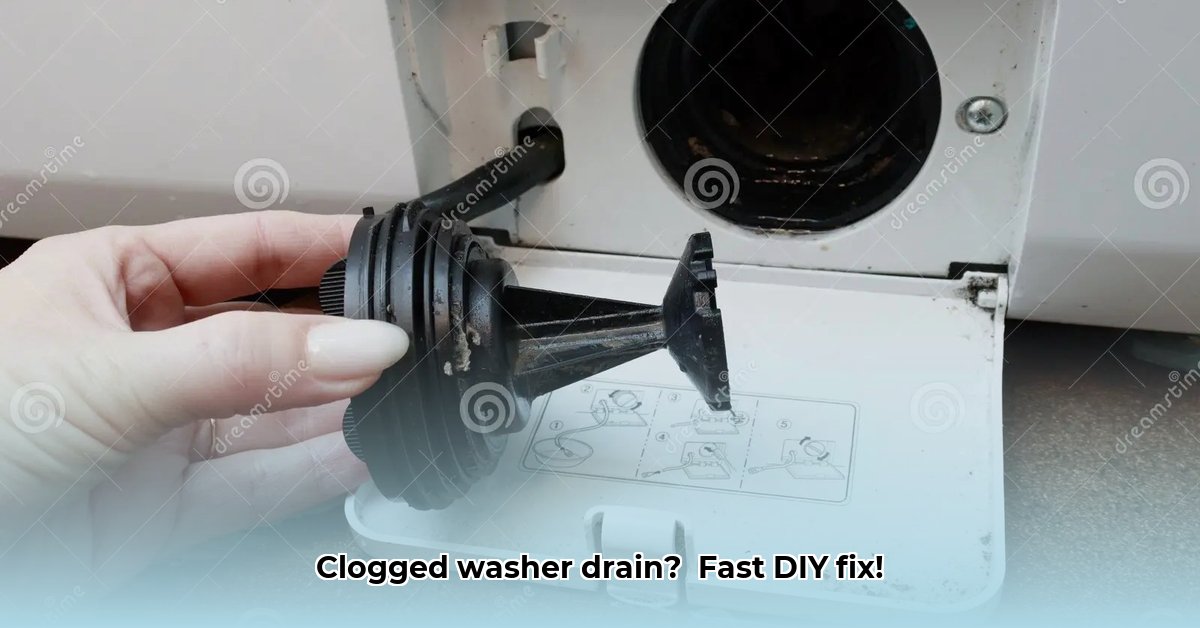Is your washing machine refusing to drain, leaving you with a tub full of water and a looming laundry disaster? Don’t reach for the phone just yet! This comprehensive DIY guide will walk you through the process of diagnosing and resolving washing machine drain clogs, from minor slowdowns to stubborn blockages. Save money and time by tackling the problem yourself with our expert tips and step-by-step instructions. For stronger chemical solutions, consider comparing drain cleaner options.
Understanding Washing Machine Drain Clogs
Before you grab your tools, it’s crucial to understand the common causes of washing machine drain clogs. The primary culprit is usually a gradual accumulation of lint, hair, soap scum, dirt, and fabric softener residue inside the drainpipe which restricts flow. Small items like socks, coins or buttons can also find their way into the drain system, causing major blockages.
Key Insights:
- Common Causes: Lint, hair, soap scum, mineral buildup, and small foreign objects.
- Clog Formation: Debris accumulates over time, gradually narrowing the drainpipe.
- Early Detection: Recognizing the signs of a slow drain can prevent more serious blockages.
Step-by-Step Guide to Unclogging Your Washer Drain
The best approach depends on the severity and location of the clog. Follow these steps in order, starting with the simplest solutions and progressing to more involved methods.
1. The Gentle Approach: Hot Water Flush
If your washing machine drains slowly, or if you’re performing preventative maintenance, a hot water flush might be all you need.
- Procedure: Carefully pour 2-3 gallons of boiling water down the drainpipe. The hot water can dissolve soap scum and loosen minor obstructions.
- Effectiveness: Best for minor slowdowns and preventative maintenance.
- Safety First: Use caution when handling boiling water to avoid burns.
2. Drain Hose Inspection and Cleaning
This step involves inspecting and cleaning the flexible drain hose that connects your washing machine to the drainpipe.
- Preparation: Turn off the water supply to the washing machine and unplug it from the electrical outlet.
- Disconnection: Carefully disconnect the drain hose from both the washing machine and the drainpipe. Have a bucket and towels nearby to catch any spilled water.
- Inspection: Examine the hose for kinks, bends, or visible blockages.
- Cleaning: Straighten the hose and use a straightened wire coat hanger, bottle brush, or plumbing snake to dislodge any debris. Flush the hose with hot water to remove remaining gunk.
- Reconnection: Reattach the drain hose to the washing machine and drainpipe, ensuring the connections are secure.
3. Drain Snake (Plumbing Auger)
If the hot water flush and drain hose cleaning don’t resolve the problem, a drain snake is your next best bet.
- Insertion: Carefully insert the snake into the drain opening, feeding it down until you encounter resistance.
- Breaking Up the Clog: Rotate the snake to break up the clog and hook onto any debris.
- Removal: Slowly pull the snake out, removing any attached debris.
- Flushing: Flush the drain with hot water to clear any remaining blockage.
- Repeat: Repeat the process if necessary until the drain flows freely.
4. Baking Soda and Vinegar Solution
This natural cleaning solution can help dissolve stubborn clogs.
- Preparation: Pour one cup of baking soda down the drain, followed by two cups of vinegar.
- Reaction: Let the mixture fizz and bubble for 20-30 minutes. The chemical reaction helps break down grease, soap scum, and other debris.
- Flush: Flush the drain with hot water to clear the loosened blockage.
5. Washing Machine Filter Check
Many washing machines have a filter designed to catch lint and debris. A clogged filter can restrict water flow and prevent proper draining.
- Location: Consult your washing machine’s owner’s manual to locate the filter (usually behind an access panel on the front or back of the machine).
- Removal: Carefully remove the filter and clean it thoroughly, removing any accumulated lint, hair, or debris.
- Reinstallation: Reinstall the filter, ensuring it is properly secured.
6. Power Auger
For stubborn clogs located deeper in the drain line, a power auger (also known as an electric drain snake) can provide more force and reach.
- Rental: Rent a power auger from a local hardware store or equipment rental company.
- Operation: Follow the manufacturer’s instructions carefully. The power auger uses a rotating cable to break up and remove stubborn clogs.
- Safety: Wear safety glasses and gloves when operating a power auger.
Preventing Future Washer Drain Issues
Prevention is always better than cure! Adopt these preventative measures to keep your washing machine drain flowing freely:
- Regular Hose Checks: Inspect and clean your drain hose every few months to remove accumulated lint and debris.
- Lint Trap Maintenance: Clean the lint trap after every wash (or at least once a week) to prevent lint buildup.
- Avoid Overloading: Overloading your washing machine can release more lint into the system, increasing the risk of clogs. Follow the manufacturer’s load capacity recommendations.
- Use Less Soap: Excessive soap can contribute to soap scum buildup. Use the recommended amount of detergent for each load.
- Avoid Washing Small Items Loose: Wash small items like socks and underwear in a mesh laundry bag to prevent them from getting lost in the drain system.
- Hot Water Washes: Occasionally run a hot water cycle with an empty machine to help dissolve soap scum and mineral buildup.
Troubleshooting Washer Drain Clogs: Location-Specific Solutions
| Problem | Possible Solutions | Next Steps If It Doesn’t Work |
|---|---|---|
| Slow or Weak Drainage | Hot water flush, baking soda and vinegar mix | Drain snake/auger, check washing machine filter |
| Standing Water in the Tub | Clean the drain hose, check washing machine filter | Commercial drain cleaner (use with caution), then auger |
| Complete Blockage | Drain snake (or power auger for stubborn clogs) | Call a plumber |
| Clog Inside Washing Machine (Filter Area) | Check and clean the filter pump (see manual) | Call a plumber |
| Recurring Clogs | Evaluate detergent usage, wash habits, and consider professional drain cleaning and inspection of drain lines. | Install a mesh filter on the drain hose to catch excess lint, consult with a plumber about potential plumbing issues. |
Important Safety Notes: Always unplug your washing machine from the power outlet before starting any repairs or maintenance. Turn off the water supply to the machine. When using chemical drain cleaners, always wear protective gloves and eye protection, and follow the manufacturer’s instructions carefully. Never mix different drain cleaners, as this can create dangerous fumes. Ensure adequate ventilation when using chemicals.
Preventative Maintenance Tips: Schedule a professional plumbing inspection every 1-2 years to identify potential drain problems before they become major headaches. Consider using a washing machine cleaner product regularly to help prevent buildup of soap scum and mineral deposits.
When to Call a Professional Plumber
If you’ve tried all the DIY methods and your washing machine drain is still clogged, it’s time to call a licensed plumber. A professional plumber has specialized tools and expertise to handle more complex drain issues, such as:
- Deep Blockages: Clogs located far down the drain line that are beyond the reach of a standard drain snake.
- Main Line Issues: Problems with the main sewer line that are affecting your entire plumbing system.
- Damaged Pipes: Collapsed, cracked, or corroded drainpipes that require repair or replacement.
- Recurring Clogs: Persistent drain problems that indicate an underlying issue that needs professional diagnosis and resolution.
- How to Stop Apps From Running in the Background to Boost Your - December 1, 2025
- How To Move Apps On Your Droid For Better Organization - November 30, 2025
- How to Move Apps on Android for Better Organization - November 29, 2025










